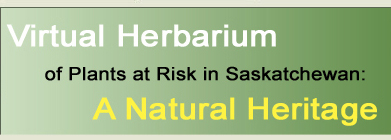|
| Atriplex truncata
(Torr. ex S. Wats.) Gray |
|
| |
| TAXONOMY |
| |
| Family: |
Chenopodiaceae |
| Genus: |
Atriplex |
| |
| Species Synonyms: |
none |
| Common Names: |
wedgescale saltbush |
| |
| DISTRIBUTION |
| |
| Canada: |
British Columbia, southeastern Alberta –
southwestern Saskatchewan |
| Saskatchewan: |
southwestern Saskatchewan; Maple Creek - Tomkins,
Webb |
| Ecoregion: |
Mixed Grassland |
| |
| HABITAT |
| |
| Saskatchewan: |
dry alkaline flats and sloughs |
| Associated Species: |
Distichlis spicata, Suaeda calceoliformis |
| |
| RARITY STATUS |
| |
Provincial
Status According
to Harms (2003): |
Endangered |
| Nature Conservancy
Status: |
G5 S1 |
Saskatchewan
Species at
Risk Status: |
None |
| COSEWIC Status:
|
None |
| |
| Atriplex truncata
is endangered in Saskatchewan because it is rare and regionally restricted.
Most local populations are small and some are threatened by human development. |
| |
| SPECIES
DESCRIPTION |
| * kranz-type venation:
appears as a dark green net pattern when leaf surface is lightly scraped
with a sharp blade under 10X magnification |
| |
|
| Height: |
10 – 40 cm |
| Roots: |
taproot |
| Stems: |
erect, branched, straw-coloured,
not prominently ridged |
| Leaves: |
alternate, sessile, 7 –
13 mm long, 5 – 7 mm wide, deltoid, base truncate or cordate, gray-farinose,
margin entire, occasionally undulate |
| Inflorescence: |
monoecious; flowers in glomerules
in terminal and axillary spikes |
| Flowers: |
pistillate bracteoles 2 –
3 mm long, triangular, base cuneate, apex rounded, apical teeth 3, united
to tip |
| Fruits: |
to 1.5 mm broad |
| |
| ATRIPLEX
KEY FOR SPECIES FOUND IN SASKATCHEWAN |
| |
| * kranz-type venation:
appears as a dark green net pattern when leaf surface is lightly scraped
with a sharp blade under 10X magnification |
| |
|
| 1 Plants perennial, woody at least
in part; leaves with kranz-type venation |
2 |
| 1 Plants annual, herbaceous throughout;
leaves with kranz-type or other venation |
3 |
| |
|
| 2 Plants woody at base; fruiting bracteoles
not winged lengthwise |
A. gardneri |
| 2 Plants woody throughout; fruiting
bracteoles prominently 4-winged lengthwise |
A. gardneri var. aptera |
| |
|
| 3 All leaves sessile |
4 |
| 3 At least some leaves petiolate |
6 |
| |
|
| 4 At least some parts of plant usually
farinose, scurfy, or otherwise pubescent; leaf base cuneate, truncate or
cordate; pistillate flowers in glomerules in terminal and axillary spikes
|
A. truncata |
| 4 Plants glabrous or nearly so; leaves
tapering to base; pistillate flowers solitary or clustered in leaf axils
|
5 |
| |
|
| 5 Leaves and stems green and glabrous
|
A. dioica |
| 5 Leaves glaucous, sparingly farinose
when young; stems reddish |
A. suckleyi |
| |
|
| 6 Plants with kranz-type* venation
|
7 |
| 6 Plants with normal dicot venation
|
9 |
| |
|
| 7 Bracteoles obovate, 4 – 8
mm long, margin dentate, usually bony and hard |
A. argentea var. argentea |
| 7 Bracteoles cuneate or oblong, 2
– 3.5 mm long, not dentate-margined or hard and bony |
8 |
| |
|
| 8 Leaves subsessile, not conspicuously
nerved; bracteoles cuneate, 2 – 3 mm long |
A. truncata |
| 8 Leaves with slender petioles, conspicuously
3-nerved, bracteoles oblong, 3 – 4 mm long |
A. powellii |
| |
|
| 9 Herbage green; bracteoles orbicular,
entire |
A. hortensis |
| 9 Herbage scurfy or mealy; bracteoles
not orbicular, toothed |
10 |
| |
|
| 10 Leaves hastate; seeds circular
|
A. prostrata |
| 10 Leaves ovate to lanceolate or linear;
seeds elliptic |
A. patula |
|






